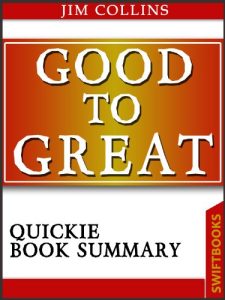Good to Great: Why Some Companies Make the Leap... and Others Don't is a 2001 management book by James C. Collins that aims to describe how companies transition from being average companies to great companies and how companies can fail to make the transition.
“Good to Great” attained long-running positions on the New York Times, Wall Street Journal and Business Week best-seller lists, sold 2.5 million hardcover copies since publication, and has been translated into 32 languages.
"Greatness" is defined as financial performance several multiples better than the market average over a sustained period. Collins finds the main factor for achieving the transition to be a narrow focusing of the company’s resources on their field of competence. Collins used a large team of researchers who studied "6,000 articles, generated more than 2,000 pages of interview transcripts and created 384 megabytes of computer data in a five-year project".
In this book summary of "Good to Great" you can discover the condensed wisdom to be gained from the book. You can discover what differences there were in companies that managed to achieve greatness.
Do you want to know the characteristics of a leader most likely to take their company from good to great? Do you want to know how to hire the right people? The book summary includes information on each of the topics covered in “Good To Great” in a format that will help you while reducing the time required for reading the entire book.
Chapter One: Good is the Enemy of Great
Chapter Two: Level 5 Leadership
Chapter Three: First Who… Then What
Chapter Four: Confront the Brutal Facts
Chapter Five: The Hedgehog Concept
Chapter Six: A Culture of Discipline
Chapter Seven: Technology Accelerators
Chapter Eight: The Flywheel and the Doom Loop
Chapter Nine: From Good to Great to Built to Last
The author of “Good to Great”, James C. "Jim" Collins, III is an American business consultant, author, and lecturer on the subject of company sustainability and growth. Jim Collins frequently contributes to Harvard Business Review, Business Week, Fortune and other magazines, journals, etc.
Collins began his research and teaching career on the faculty at Stanford University's Graduate School of Business, where he received the Distinguished Teaching Award in 1992. In 1995, he founded a management laboratory in Boulder, Colorado, where he now conducts research and teaches executives from the corporate and social sectors.
“Good to Great” attained long-running positions on the New York Times, Wall Street Journal and Business Week best-seller lists, sold 2.5 million hardcover copies since publication, and has been translated into 32 languages.
"Greatness" is defined as financial performance several multiples better than the market average over a sustained period. Collins finds the main factor for achieving the transition to be a narrow focusing of the company’s resources on their field of competence. Collins used a large team of researchers who studied "6,000 articles, generated more than 2,000 pages of interview transcripts and created 384 megabytes of computer data in a five-year project".
In this book summary of "Good to Great" you can discover the condensed wisdom to be gained from the book. You can discover what differences there were in companies that managed to achieve greatness.
Do you want to know the characteristics of a leader most likely to take their company from good to great? Do you want to know how to hire the right people? The book summary includes information on each of the topics covered in “Good To Great” in a format that will help you while reducing the time required for reading the entire book.
Chapter One: Good is the Enemy of Great
Chapter Two: Level 5 Leadership
Chapter Three: First Who… Then What
Chapter Four: Confront the Brutal Facts
Chapter Five: The Hedgehog Concept
Chapter Six: A Culture of Discipline
Chapter Seven: Technology Accelerators
Chapter Eight: The Flywheel and the Doom Loop
Chapter Nine: From Good to Great to Built to Last
The author of “Good to Great”, James C. "Jim" Collins, III is an American business consultant, author, and lecturer on the subject of company sustainability and growth. Jim Collins frequently contributes to Harvard Business Review, Business Week, Fortune and other magazines, journals, etc.
Collins began his research and teaching career on the faculty at Stanford University's Graduate School of Business, where he received the Distinguished Teaching Award in 1992. In 1995, he founded a management laboratory in Boulder, Colorado, where he now conducts research and teaches executives from the corporate and social sectors.






